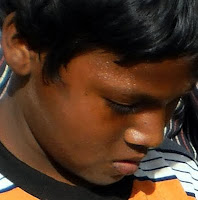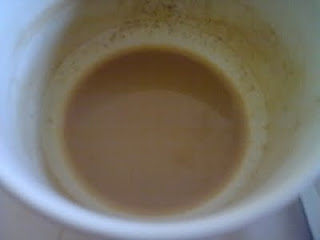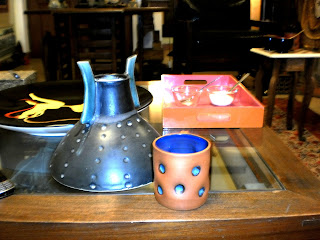 |
| Wild grass and the Loha Pul [entrance to Project Y] |
The first memory that I recounted to Ines was of a holiday we took as a family in 1971 to Manali and stayed in a log hut in the mountains, overlooking the roaring River Beas. I remember the sound as much as I do the way the water rushed down stream because I had spent hours, even days trying to capture its waters swirling around a huge boulder, on my canvas. It was a child’s painting; an inadequate representation of the awesome power of water. The roar of its force as a billion gallons ran down the mountainside at such speed is something I still listen out for whenever I am in the vicinity of mountains. But, have to confess that I have never found the experience to be quite as enthralling as this one, when I was twelve years old. What had drawn my attention was the way this fearsome, rapid water, ran over a huge boulder effortlessly, without stopping or struggling. Its ability to silently circumvent obstacles that came in its path, rather than bludgeon through, destroying them with wrath, is another facet I remember not being able to bring to life on the canvas. Much to my embarrassment, this painting hung on my father’s office wall, behind his desk for years, visible to every visitor or colleague. I have no idea why he was so proud of it but, being there, it reminded me again and again of my inadequacy to represent what I had felt and seen.
 |
| Ines Lechleitner during her performance [with me] |
When Ines asked me to recount, I was unable to say all of this, but her art performance triggered this memory and I became curious. Why did this particular recollection come to the fore? And not those of many afternoons spent on the Shikaras[i] on Dal Lake in Srinagar or the Thames in London on whose banks at Cheyne Walk I had lived for more than four years, as a student. I recollect standing on Battersea Bridge, in the freezing cold at night, to draw the night lights on Albert Bridge. I also remember visiting the Niagara Falls, again in winter, and walking through icicles. There have been so the many water bodies I have encountered on my travels, in Scotland or even on the Okinawa islands in Japan, but it was this early memory that was foremost, not the others.
When we moved to Delhi from Calcutta in 1969, we lived in Maharani Bagh and then later in Friends Colony [East], both of which are close to the River Yamuna. I remember one year, I think it was 1977 or maybe 1978, when the Yamuna almost flooded. We would go to the embankment every evening to see the level the water had risen to. One day when it reached just about 1” below the wall in Kalindi, we were told that even a millimetre above the wall would cause massive flooding. Everyone moved all their furniture to the first floor, but thankfully the flood never came. The water receded and somehow the Yamuna has never been quite the same again.
 |
| Atul Bhalla's Installation against the Loha Pul |
 |
| Sheba Chachhi's Installation on the River Yamuna |
I thought of myself as the River Yamuna and wondered what she would think of her place in contemporary society. A river, people now, only visit to immerse ashes of their dead; she is no longer the water body that was once revered. Her revolt seems to be in evidence. Her water is undrinkable. Most localities in Delhi do not have sufficient potable water, but we have not yet learned. We still dump our waste in this. Later, as I took a motor boat to see Asim Waqif's installation in the water and also Sheba Chhachhi’s white, unidentified, almost-abstract, floating form that could have been a yoni, or two legs or even two arms with hands held together in prayer, the stench was devastating. It smelt of sewage and, as Atul put it, all the drains of Delhi lead into the Yamuna; therefore it’s really no better than a sewer. Her insanity was in evidence too; she endured, had endured for centuries and that she still flows is testimony to this. It reminded me of the River Beas I had tried to capture in all its fury running down huge boulders, gently caressing the surface, circumventing the rocks as if in complete understanding and acceptance of their role in the eco-system, however irksome to the river’s flow.
 |
| Black water reflects the sunset to perfection |
The Yamuna water looked black, reflecting the sunset to perfection and had it not been for the stench, silhouettes of the birds that flew overhead would have made a wonderful picture, on this dark surface, reflecting a pinkish-russet sunset. The many faces of nature are baffling indeed, making me consider whether we can ever fully grasp this.
 |
| Atul on the motor-boat ride, Asim Waqif's installation behind him |
Environmentalists and now artists are crying about an imbalance in the eco-system, implying we are not taking cognisance of its fragility and, I wonder, whether it’s the fragility of nature at stake or the fragility of man to accept his own power of harnessing nature with the same grace that this water seems to accept our offerings of plastic bags, waste and marigold as well as ashes of cremated bodies. I recollect Art of Living’s Sri Sri Ravi Shankar had spoken about a campaign for cleaning up the Yamuna, so asked Atul who accompanied me on the motor-boat ride, what happened to that project and was told: “All these campaigns are mere theatrics. We need massive sewage treatment plants to clean up this river.”
 |
| Gigi Scaria's Tower |
Gigi Scaria’s tower, meant to purify the water threw up a fountain of really dirty water – the tower spouted a darkish liquid, which was anything put purified. Showing us just how putrefied this water had become. Yet the bowl of water that Ines had collected was not that bad. It was not quite as clean as the water she had carried from the Elbe, but just slightly hazier than this, not the muddy fountain that was being spewed from Gigi’s purification tower. Leaving yet another trail of thought and questions about the real state of its being and also about our perception of things: how a glass bowl, with its own transparency, seemed to clarify what looked immensely black when I rowed its depth and equally dark and threatening as it seemingly refused to be cleansed by an artist’s endeavour, as if mocking his attempt.
 |
| Chappals and the keechad |
What the future holds in respect of our natural resources, whether nature will inflict her fury or man will self-destruct are questions no-one has answers for. Project Y did however make me question various parameters of existence, recollect memories, roam uninhibitedly on the sand, letting the reta mitti[ii] sift through my chappalled[iii] feet, walk among the wild, uncultivated foliage - mostly rushes and weeds, and through keechad[iv], feeling liberated from the otherwise constraining factors of urban living. I was blissfully able to disconnect with this, let go of the need to control the emotions in order to get by. Inspired by the water and her philosophy I re-discovered compassion; however insane it may seem in a world where being ruthless is admired and goodness is seen as naive and foolish.
 |
| Still from Vivan Sundaram's video |
Finishing off my exploration with a cup of tea, I chatted with Deeksha Nath, her mother, her seventeen month old son and husband Kabir, Meera Menezes and Atul Bhalla. Rounded off the experience watching Vivan Sundaram’s video of his homage to the Yamuna showing a raft made of thousands of ‘Himalaya spring water’ plastic bottles, the caps all the same tone of bright, chameli [v]pink being lowered onto the waters of the Yamuna and rowed with a priest seated on it, dressed in full regalia. As the journey was deemed finished, the raft of plastic water bottles was ruthlessly broken into pieces, on camera. It was a visually seductive video with the pink bottle caps and the Loha Pul[vi] in the background. A major landmark of the Jubilee Gardens, the iron railway-cum-motor bridge carries, to this day, trains and cars to and from Old Delhi railway station. In all the years I have lived in Delhi, I have no recollection of this bridge or, for that matter even taking a train from Old Delhi Railway Station. However, I did reach there today by travelling on this bridge; a novel experience indeed.
 |
| Asim Waqif's Installation against the Bridge |
 |
| Inside the car on the Loha Pul en route to Project Y |
The River Yamuna was there when the Mughal’ s built their forts, the British came to trade and stayed to rule and also when they went and the blood of partition brought thousands from Pakistan who settled in Delhi. She was there when the Pandavas of the Mahabharat were in exile and she is there today. This river has been able to endure much more than we give nature credit for. Maybe the fear we have of eroding her resources is just a perception based upon a limited exploration of our own expandable and enduring nature? It’s not that I condone the filth and stench. We certainly have to find the means to cleanse this water body; we must re-pay the debt of her life-sustaining water. But for me this exploration on the banks of the Yamuna has been more of an inspiration than a lament. The River has seen interesting times. Her nature is enduring, her muteness seems foolish yet, is also wise in thus accepting her designate role in life; flowing from one state to the next. Isn’t this the stuff that all our lives are made of?























